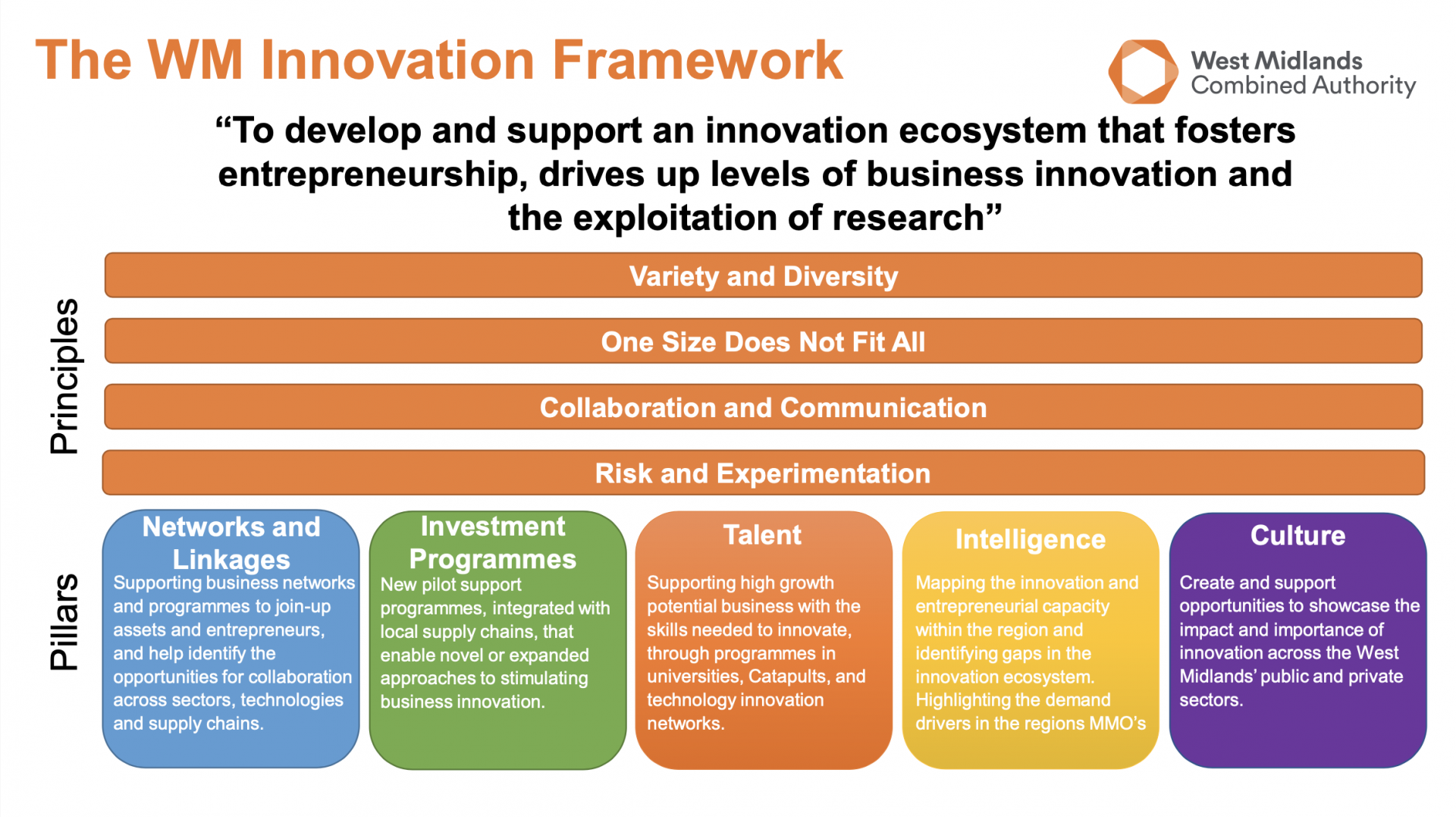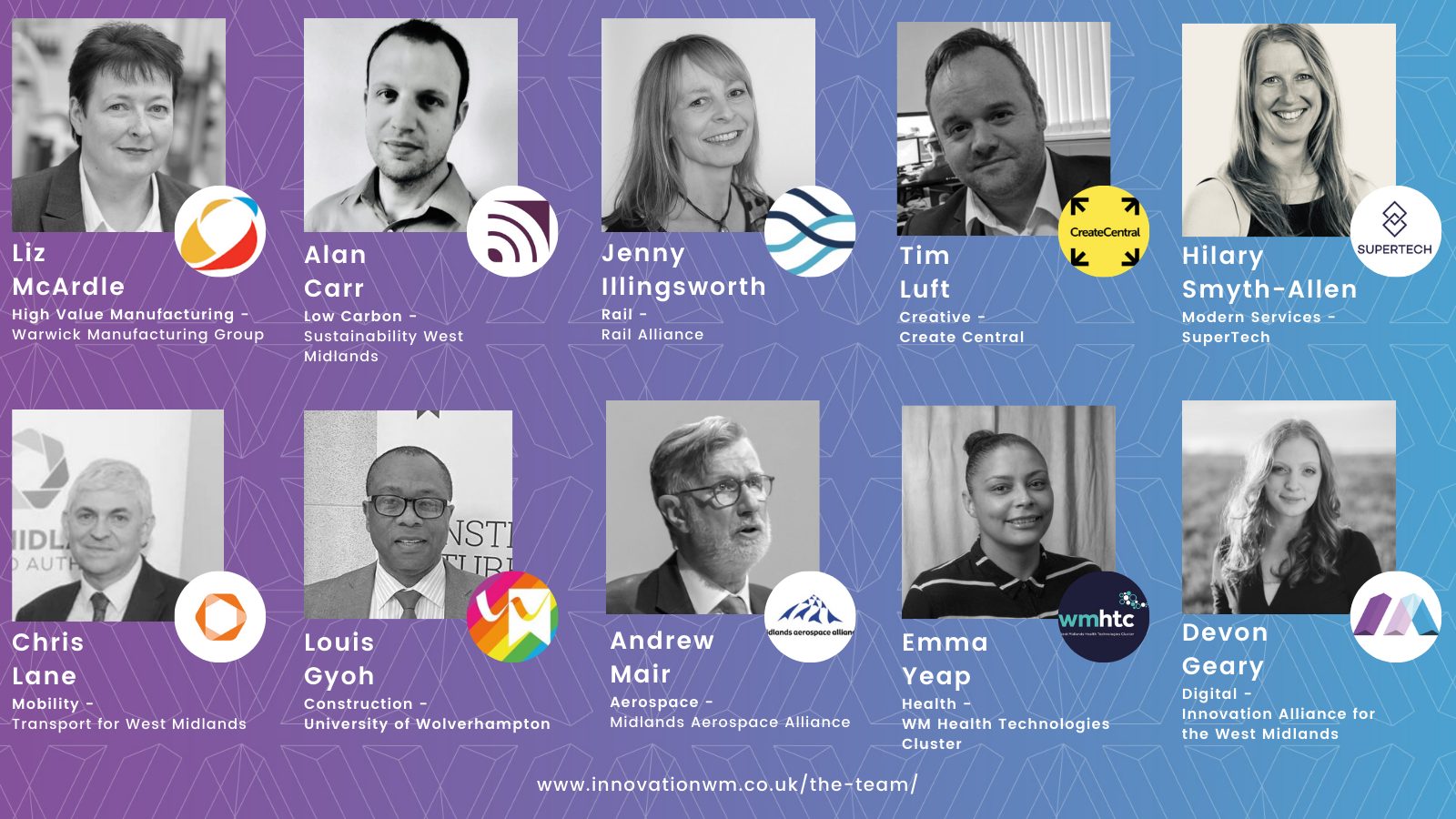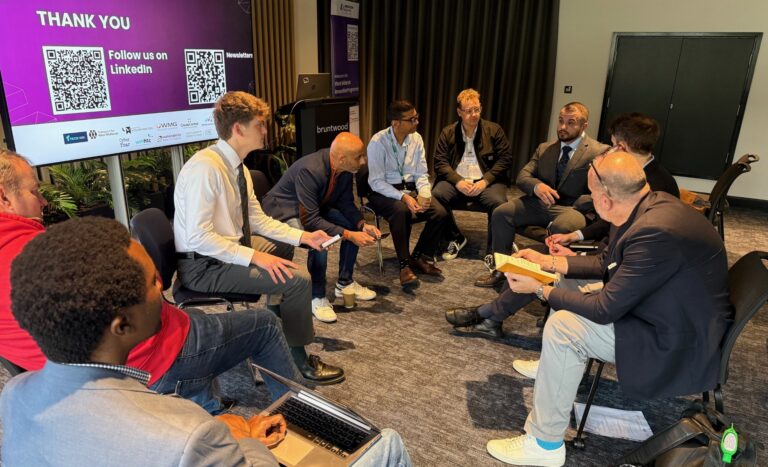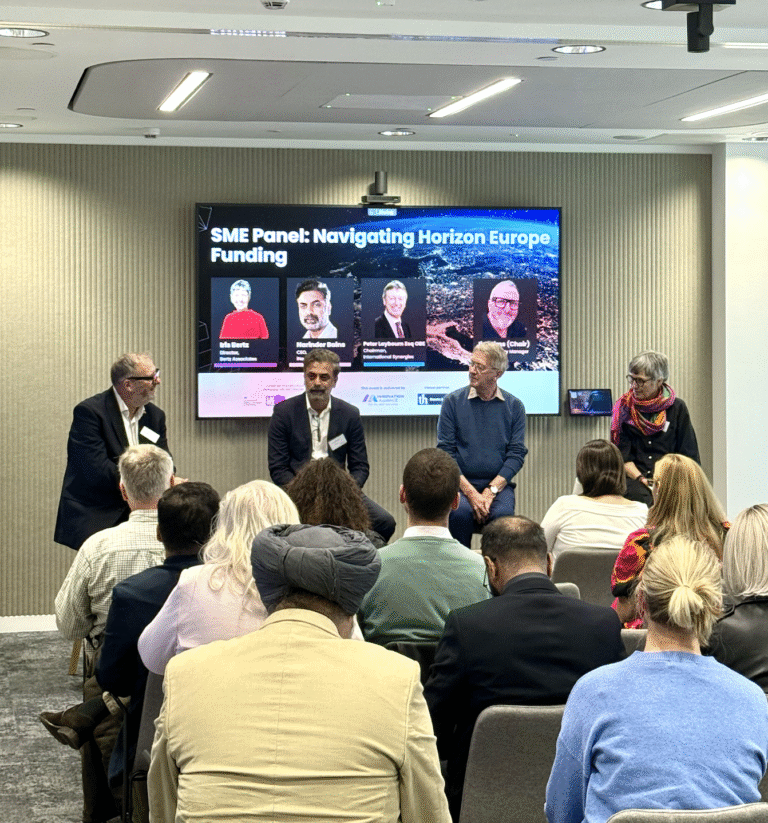On Tuesday, 20 April 2021, 81 people from the Innovation Alliance WM’s networks joined the Innovation Policy and Practice (IP&P) event called “Meet the Virtual Innovation Team—Supporting WM Business”. The session included an overview of the West Midlands Innovation Programme (WMIP), an introduction to the Virtual Innovation Team (VIT) and the VIT Sector Leads, and two breakout discussions designed to spark cross-sector collaborative thinking and proposals. The meeting took place on Zoom. Recordings and slides are available to view. Links are included at the bottom of this page.
Throughout the event, conversations emphasised the importance of demand-led innovation, cross-sector collaborations, and challenge-based projects and initiatives that connect public- and private-sector purchasing bodies with local businesses (including SMEs) that may have—or can develop—innovative solutions.
An Overview of the West Midlands Innovation Programme (WMIP)
Jamie Elliott, Innovation Lead at the West Midlands Combined Authority (WMCA), opened the event by sharing an overview of the West Midlands Innovation Programme (WMIP). “Innovation,” he said, “is a contact sport.” It requires cross-sector collaboration and a willingness to share best practices with colleagues from various industries and sectors. Together, these approaches will equip the region to bounce forward after COVID-19, in part through embracing digital as an enabler of innovation. This all works toward the WMCA’s goal of making the West Midlands the UK’s Innovation Region. WMIP has created the Virtual Innovation Team (VIT) with this in mind.

As shown in the image above, WMIP partners include the WMCA (funder) and its Innovation Board, the Innovation Alliance for the West Midlands (IAWM) Executive Team, and the 8 partner organisations that make up the business-facing Virtual Innovation Team (VIT).
WMIP aims to drive up levels of demand-led business innovation across all areas of the region by delivering a stronger, more integrated innovation support offer to business and providing targeted support to business to access more national innovation funding. Broadly speaking, this activity includes the following:

- Understanding the needs of companies across the region
- Developing new innovation support initiatives
- Influencing the development of region-wide business support packages that incorporate innovationthroughout
- Working with partners (such as Innovation Alliance for the West Midlands) to promote the region’s major market opportunities and the region’s innovation ecosystem, supporting their exploitation
WMIP focuses on all the areas of action in the innovation pillar of the WM Local Industrial Strategy and Recovery Plans.
WMIP is currently halfway through its 3-year pilot. Outputs to date are shown in image 2, below:

The VIT Sector Leads have played a vital role in delivering these outputs.
Meet the Virtual Innovation Team Sector Leads
The Virtual Innovation Team (VIT) comprises business-facing innovation experts hosted by a range of regional cluster/ sector bodies. Between them they support businesses in all the sectors and major market opportunities of the WM Local Industrial Strategy . The focus is on equipping local businesses to recover and grow through innovation.
The VIT Team members are:

The beauty of the VIT is that team members bring the depth of their sector expertise, the breadth of their networks, and their passion for innovation into each conversation. This means the team has been able to accomplish much at a high level in a relatively short window of time. The VIT’s core strength lies in the Sector Leads’ ability to leverage the collective strength of its eight partner organisations, both to develop innovation within their sector, as they demonstrated during the two Breakout discussions.
Breakout Session A
In this breakout session, VIT Sector Leads who have already worked together on cross-sector pilot projects shared an overview of the work they’ve done thus far. Highlights and key takeaways from each breakout room included the following:
- Low Carbon and Creative (featuring Innovation Engine 3 Project)
This project will bring Creative and Low Carbon companies together to solve large-scale sustainability challenges for partner organisations (e.g. Commonwealth Games). The format will bring small businesses to the attention of large projects and utilise existing skills, expertise, and technologies across the region to address vital challenges. Importantly, challenge holders are required to maintain a legacy of working with small businesses after the Innovation Engine 3 project has completed. Key challenges could include:
- Monitoring air quality (alongside the Clean Air Zone)
- Demystifying Circular Economy
- Streamlining data capture
- Battery recycling (like AceOn—shared as a case study)
- Aerospace and Health (featuring Pivot Project)
The Pivot project focuses on equipping businesses to transition into the Aerospace industry, which leverage similar regulatory environments and innovation models across the medical technologies and aerospace industries. Pivot helps businesses identify products, processes, and solutions they use in their current industries (e.g.. medical technologies) that could be applicable in the aerospace industry. Once this pilot project has been proven successful, the VIT sector leads have discussed rolling it out across industries and sectors to further facilitate cross-sector collaborative solutions to manufacturing challenges.
- Manufacturing and Digital (featuring Made Smarter)
The Made Smarter programme focuses on digitisation of manufacturing. Examples include using industrial digital technologies, such as robotics, Artificial Intelligence, and others, to digitise and streamline manufacturing processes.
Jamie Elliott also mentioned that the programme aims to link support programmes for Manufacturing to the Growth Hubs and to reduce fragmentation within business support programmes across the region.
- Construction, Mobility, and Rail (Infrastructure, Place, and Innovation)
Discussion revolved around Very Light Rail (VLR), data and construction projects that utilise 5G, and real-time data linkages in vehicles via 5G.
VLR is a disruptive innovation within the rail industry that is designed to reduce manufacturing and maintenance costs. Consequently, VLR is expected to increase mobility across cities, allow closed rail stations to reopen, and provide efficient rail that minimises operational costs.
VIT Sector Leads invited participants to consider how VLR and 5G might impact their industries and organistaions post-COVID.
Breakout Session B
In this breakout session, VIT sector leads who have not already worked together on projects facilitated conversations to spark ideas about how they might collaborate on new projects and approaches in the coming months. Highlights and key takeaways included the following:
- Creative and Manufacturing
The creative industries’ expertise in storytelling can help companies in the Manufacturing sector:
- Engage with people (colleagues and potential customers) Explain various technologiesDevelop effective and impactful change management programmes
The Manufacturing sector also benefits from creative data visualisation, product design, and collaboration inspired by the creative industries.
One participant pointed out that engineers and creatives are curious in different ways. Bringing these two types of curiosity together sparks exciting innovation.
- Low Carbon and Aerospace
Conversation focused heavily on the need for challenge-led innovation. VIT Sector Leads discussed a GBSLEP Innovation Pilot they both participated in. Sector leads worked with challenge holders to identify challenges for Low Carbon, Manufacturing, Health, and Social Care sectors. Low Carbon challenges focused on air quality. Manufacturing challenges focused on electrification (including batteries and electric vehicles). This pilot concluded with a Dragon’s-Den-style showcase. Participants expressed interest in joining this sort of activity in the future.
Andrew Mair emphasised the need for a demand-led / challenge approach from the supplier side and shared that, it is often difficult for customers to know and define their challenges. A translation exercise is needed to rectify this. Regulated sectors may require bigger projects with higher levels of support.
- Mobility and Health
Conversation centred around how Transport for the West Midlands (TfWM)’s recent innovations in transport can help drive positive health and wellbeing outcomes across the region.
Chris Lane also presented the Future Transport Zone, which aims to “empower and enable people to make sustainable travel decisions,” and whose Legacy includes understanding behaviour around transport. This work will make targeted transport inventions possible. The data architecture is then capable of managing a network of increased diversity and complexity
And finally, the Mobility Hubs idea was presented as a solution for post-COVID living, working, and socialising. (This potentially links to the Repurposing City Centres and Town Centres proposal discussed in the Construction and Digital session, below.)
- Construction and Digital
Susannah Goh discussed potential uses of 5G in construction and introduced the Repurposing of Town and City Centres proposal.
5G could be used to monitor speed, accuracy, quality, and health and safety of construction sites, including the work completed onsite and people’s behaviour.
Participants then engaged in a robust discussion about working and innovation in the new normal. Some argued that the flexibility of remote working will trump workers’ desire to be in the office and with colleagues. Others argued that, because innovation is a contact sport, it requires physical proximity. Town and city centres are busy in the evenings, which suggests people are craving in-person connections and interactions. All agreed we need an offer that will encourage people to return to work.
Reflections
Innovation is key to the region’s post-COVID economic recovery. And innovation is, decidedly, a contact sport. As participants discussed at length, work, life, and innovation will look very different as we progress forward out of lockdown in the coming months. We are constantly developing new ways of doing business, interacting with customers, and building relationships with colleagues. All of this means our sectors are ripe for disruption, innovation, and creativity. We must be willing to challenge our beliefs about what is within the realm of the possible, step outside our comfort zones, and explore opportunities to innovate collaboratively. When we do this, we will be one step closer to bouncing forward and Building Back Better.
Thank you to everyone who joined us for the “Meet the Virtual Innovation Team—Supporting WM Business” event. We are grateful to our stakeholders for your continued enthusiasm and engagement toward foster collaborative, cross-sector innovation across the West Midlands.
You can revisit the main event slides (including Jamie Elliott’s overview of WMIP) here.
We look very much forward to seeing you at the next Innovation Policy and Practice meeting on 6th July (details to follow).
Author: Devon Geary, Networks and Partnerships Manager, Innovation Alliance for the West Midlands





